Risk Factors, Nursing Assessment, and COPD: A Case Study Analysis
VerifiedAdded on 2022/11/29
|8
|1783
|312
Report
AI Summary
This report presents a case study of Mrs. Anya Strico, a 75-year-old woman with COPD, focusing on the identification of risk factors such as breathlessness, chest tightness, and chronic cough. It details the nursing assessment process, emphasizing the gathering of patient history and the formulation of care plans, including medication and mobility support. The report highlights the importance of priority populations, particularly those over 65, and the application of the national strategic framework for chronic conditions to promote health and reduce risks. It also discusses the significance of self-management priorities, active patient engagement, and the goals of the national framework in improving patient outcomes. The conclusion summarizes the key findings regarding risk factors, nursing assessments, and the application of the strategic framework to enhance patient care and self-management strategies for individuals with chronic conditions like COPD.
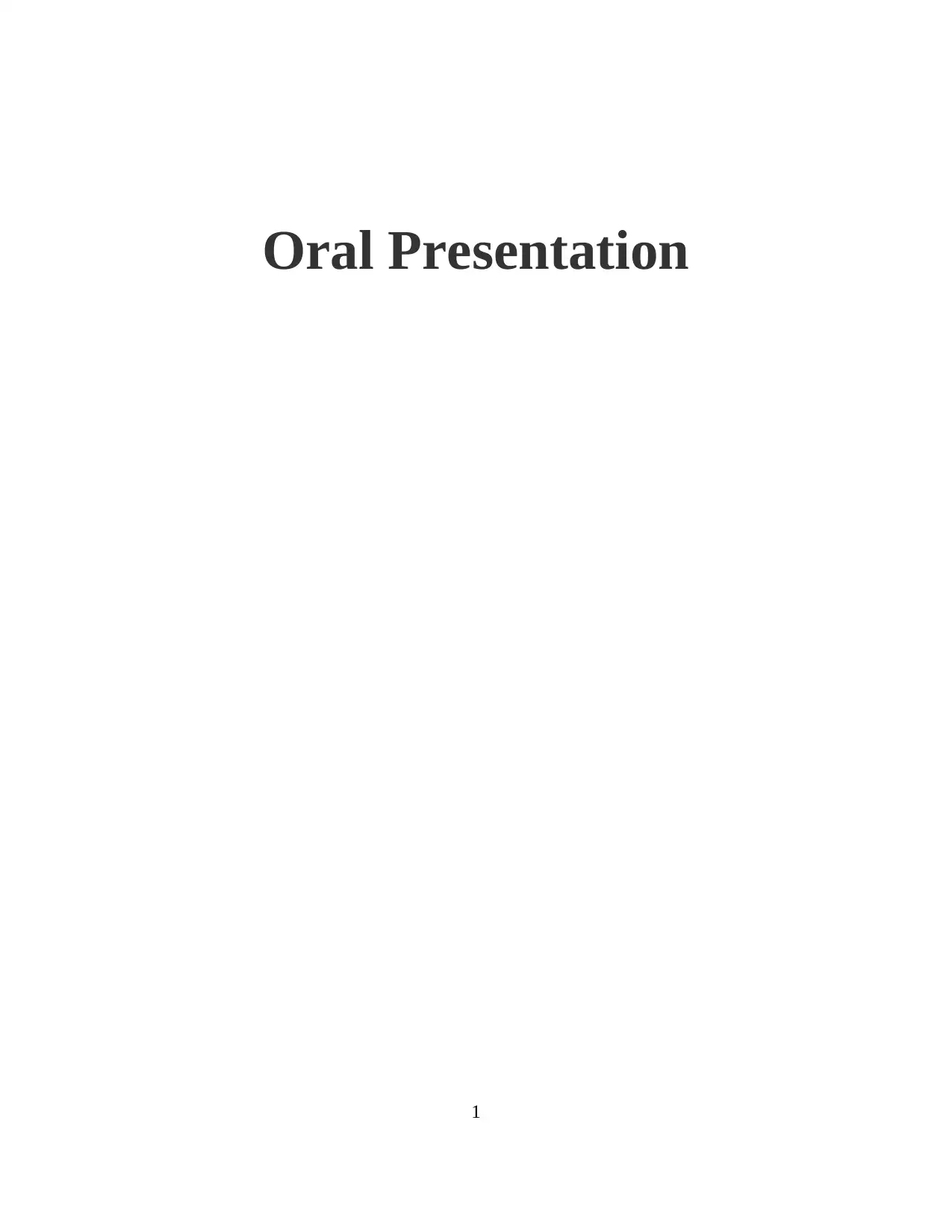
Oral Presentation
1
1
Paraphrase This Document
Need a fresh take? Get an instant paraphrase of this document with our AI Paraphraser
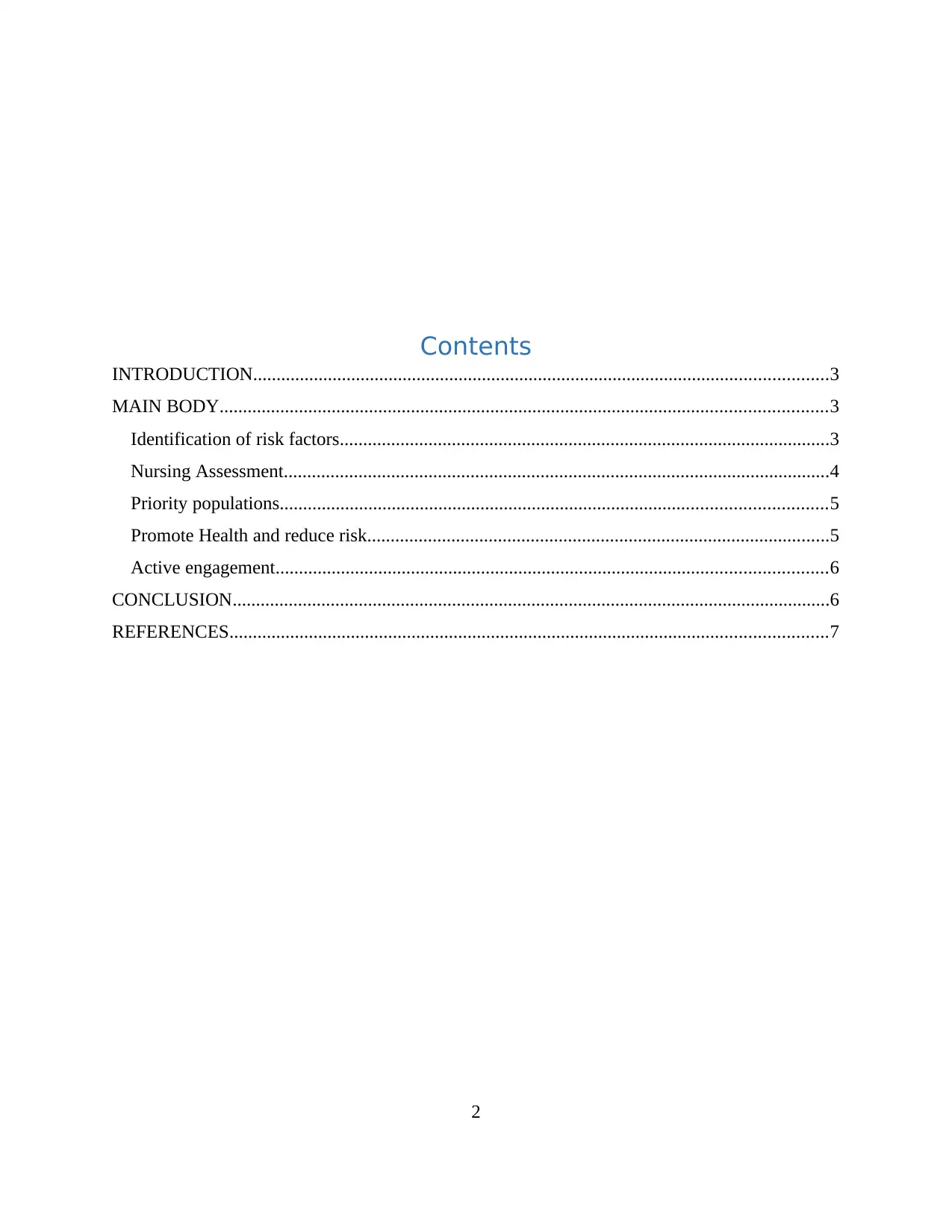
Contents
INTRODUCTION...........................................................................................................................3
MAIN BODY..................................................................................................................................3
Identification of risk factors.........................................................................................................3
Nursing Assessment.....................................................................................................................4
Priority populations.....................................................................................................................5
Promote Health and reduce risk...................................................................................................5
Active engagement......................................................................................................................6
CONCLUSION................................................................................................................................6
REFERENCES................................................................................................................................7
2
INTRODUCTION...........................................................................................................................3
MAIN BODY..................................................................................................................................3
Identification of risk factors.........................................................................................................3
Nursing Assessment.....................................................................................................................4
Priority populations.....................................................................................................................5
Promote Health and reduce risk...................................................................................................5
Active engagement......................................................................................................................6
CONCLUSION................................................................................................................................6
REFERENCES................................................................................................................................7
2
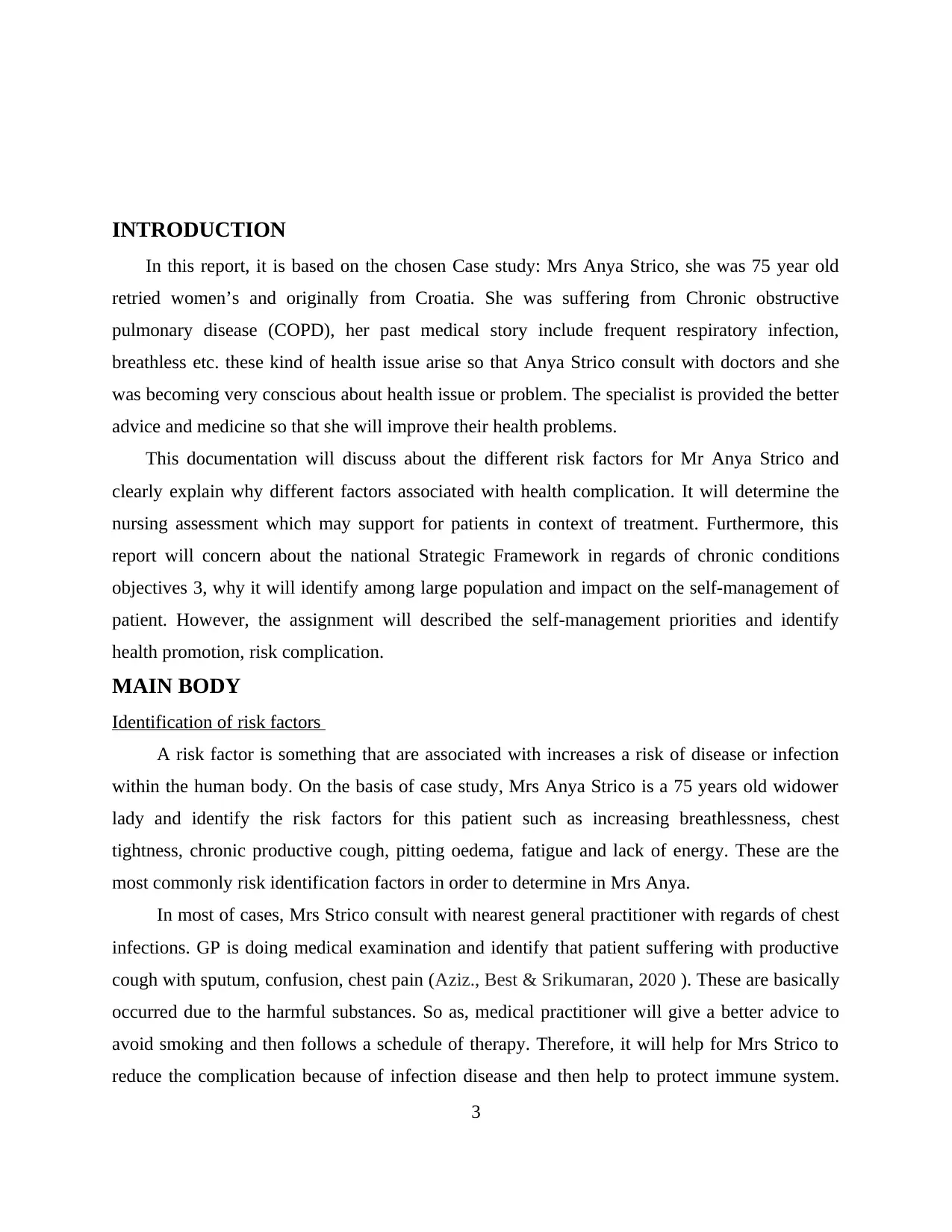
INTRODUCTION
In this report, it is based on the chosen Case study: Mrs Anya Strico, she was 75 year old
retried women’s and originally from Croatia. She was suffering from Chronic obstructive
pulmonary disease (COPD), her past medical story include frequent respiratory infection,
breathless etc. these kind of health issue arise so that Anya Strico consult with doctors and she
was becoming very conscious about health issue or problem. The specialist is provided the better
advice and medicine so that she will improve their health problems.
This documentation will discuss about the different risk factors for Mr Anya Strico and
clearly explain why different factors associated with health complication. It will determine the
nursing assessment which may support for patients in context of treatment. Furthermore, this
report will concern about the national Strategic Framework in regards of chronic conditions
objectives 3, why it will identify among large population and impact on the self-management of
patient. However, the assignment will described the self-management priorities and identify
health promotion, risk complication.
MAIN BODY
Identification of risk factors
A risk factor is something that are associated with increases a risk of disease or infection
within the human body. On the basis of case study, Mrs Anya Strico is a 75 years old widower
lady and identify the risk factors for this patient such as increasing breathlessness, chest
tightness, chronic productive cough, pitting oedema, fatigue and lack of energy. These are the
most commonly risk identification factors in order to determine in Mrs Anya.
In most of cases, Mrs Strico consult with nearest general practitioner with regards of chest
infections. GP is doing medical examination and identify that patient suffering with productive
cough with sputum, confusion, chest pain (Aziz., Best & Srikumaran, 2020 ). These are basically
occurred due to the harmful substances. So as, medical practitioner will give a better advice to
avoid smoking and then follows a schedule of therapy. Therefore, it will help for Mrs Strico to
reduce the complication because of infection disease and then help to protect immune system.
3
In this report, it is based on the chosen Case study: Mrs Anya Strico, she was 75 year old
retried women’s and originally from Croatia. She was suffering from Chronic obstructive
pulmonary disease (COPD), her past medical story include frequent respiratory infection,
breathless etc. these kind of health issue arise so that Anya Strico consult with doctors and she
was becoming very conscious about health issue or problem. The specialist is provided the better
advice and medicine so that she will improve their health problems.
This documentation will discuss about the different risk factors for Mr Anya Strico and
clearly explain why different factors associated with health complication. It will determine the
nursing assessment which may support for patients in context of treatment. Furthermore, this
report will concern about the national Strategic Framework in regards of chronic conditions
objectives 3, why it will identify among large population and impact on the self-management of
patient. However, the assignment will described the self-management priorities and identify
health promotion, risk complication.
MAIN BODY
Identification of risk factors
A risk factor is something that are associated with increases a risk of disease or infection
within the human body. On the basis of case study, Mrs Anya Strico is a 75 years old widower
lady and identify the risk factors for this patient such as increasing breathlessness, chest
tightness, chronic productive cough, pitting oedema, fatigue and lack of energy. These are the
most commonly risk identification factors in order to determine in Mrs Anya.
In most of cases, Mrs Strico consult with nearest general practitioner with regards of chest
infections. GP is doing medical examination and identify that patient suffering with productive
cough with sputum, confusion, chest pain (Aziz., Best & Srikumaran, 2020 ). These are basically
occurred due to the harmful substances. So as, medical practitioner will give a better advice to
avoid smoking and then follows a schedule of therapy. Therefore, it will help for Mrs Strico to
reduce the complication because of infection disease and then help to protect immune system.
3
⊘ This is a preview!⊘
Do you want full access?
Subscribe today to unlock all pages.

Trusted by 1+ million students worldwide
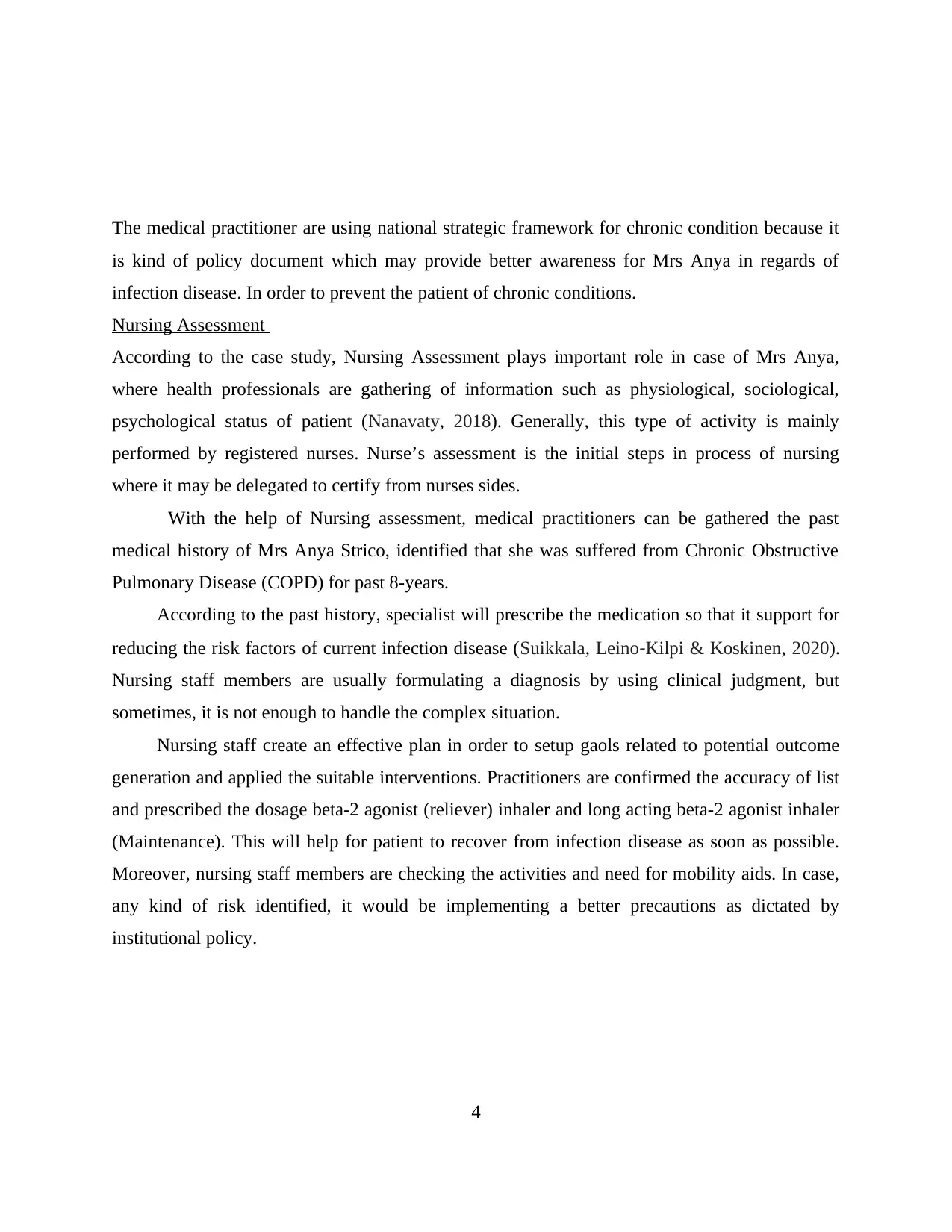
The medical practitioner are using national strategic framework for chronic condition because it
is kind of policy document which may provide better awareness for Mrs Anya in regards of
infection disease. In order to prevent the patient of chronic conditions.
Nursing Assessment
According to the case study, Nursing Assessment plays important role in case of Mrs Anya,
where health professionals are gathering of information such as physiological, sociological,
psychological status of patient (Nanavaty, 2018). Generally, this type of activity is mainly
performed by registered nurses. Nurse’s assessment is the initial steps in process of nursing
where it may be delegated to certify from nurses sides.
With the help of Nursing assessment, medical practitioners can be gathered the past
medical history of Mrs Anya Strico, identified that she was suffered from Chronic Obstructive
Pulmonary Disease (COPD) for past 8-years.
According to the past history, specialist will prescribe the medication so that it support for
reducing the risk factors of current infection disease (Suikkala, Leino‐Kilpi & Koskinen, 2020).
Nursing staff members are usually formulating a diagnosis by using clinical judgment, but
sometimes, it is not enough to handle the complex situation.
Nursing staff create an effective plan in order to setup gaols related to potential outcome
generation and applied the suitable interventions. Practitioners are confirmed the accuracy of list
and prescribed the dosage beta-2 agonist (reliever) inhaler and long acting beta-2 agonist inhaler
(Maintenance). This will help for patient to recover from infection disease as soon as possible.
Moreover, nursing staff members are checking the activities and need for mobility aids. In case,
any kind of risk identified, it would be implementing a better precautions as dictated by
institutional policy.
4
is kind of policy document which may provide better awareness for Mrs Anya in regards of
infection disease. In order to prevent the patient of chronic conditions.
Nursing Assessment
According to the case study, Nursing Assessment plays important role in case of Mrs Anya,
where health professionals are gathering of information such as physiological, sociological,
psychological status of patient (Nanavaty, 2018). Generally, this type of activity is mainly
performed by registered nurses. Nurse’s assessment is the initial steps in process of nursing
where it may be delegated to certify from nurses sides.
With the help of Nursing assessment, medical practitioners can be gathered the past
medical history of Mrs Anya Strico, identified that she was suffered from Chronic Obstructive
Pulmonary Disease (COPD) for past 8-years.
According to the past history, specialist will prescribe the medication so that it support for
reducing the risk factors of current infection disease (Suikkala, Leino‐Kilpi & Koskinen, 2020).
Nursing staff members are usually formulating a diagnosis by using clinical judgment, but
sometimes, it is not enough to handle the complex situation.
Nursing staff create an effective plan in order to setup gaols related to potential outcome
generation and applied the suitable interventions. Practitioners are confirmed the accuracy of list
and prescribed the dosage beta-2 agonist (reliever) inhaler and long acting beta-2 agonist inhaler
(Maintenance). This will help for patient to recover from infection disease as soon as possible.
Moreover, nursing staff members are checking the activities and need for mobility aids. In case,
any kind of risk identified, it would be implementing a better precautions as dictated by
institutional policy.
4
Paraphrase This Document
Need a fresh take? Get an instant paraphrase of this document with our AI Paraphraser
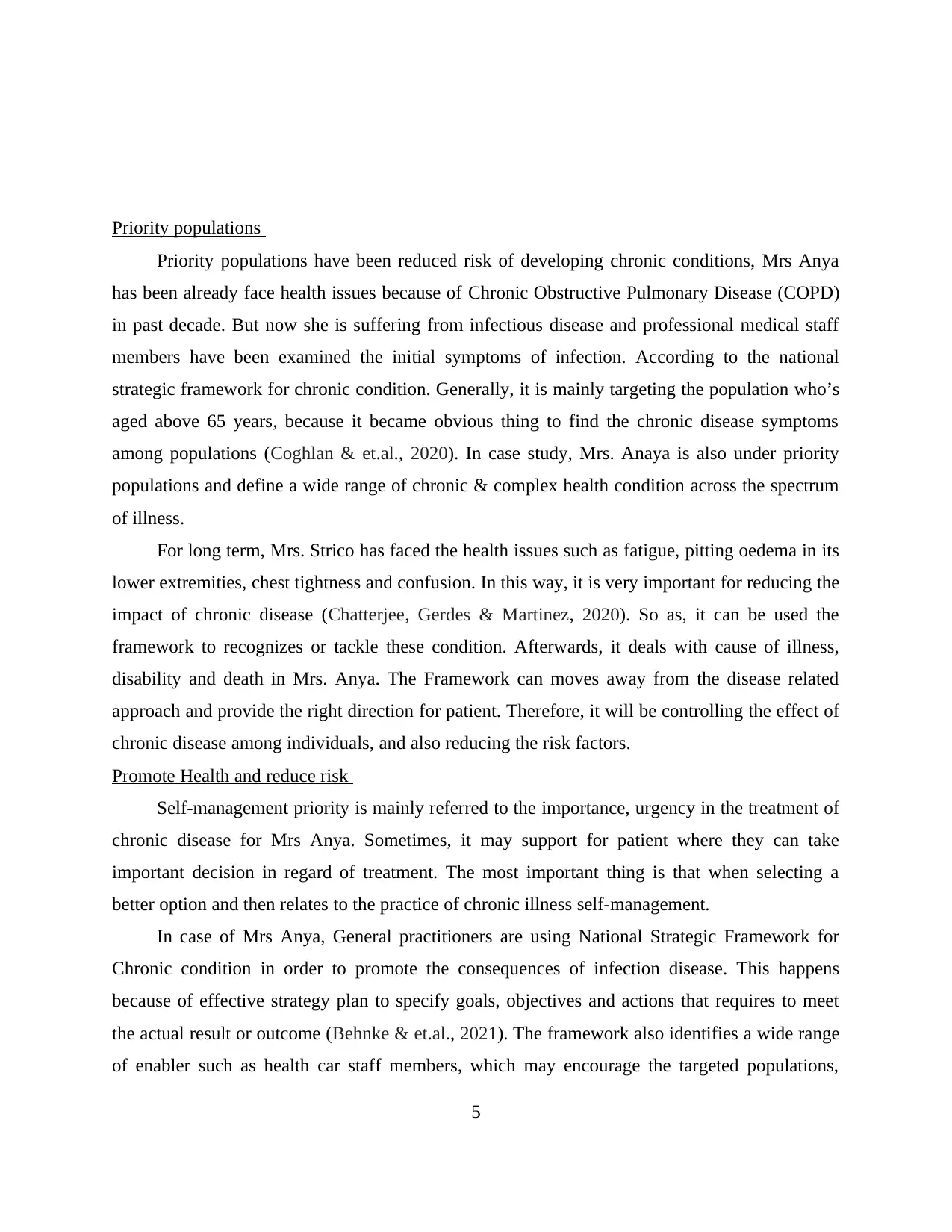
Priority populations
Priority populations have been reduced risk of developing chronic conditions, Mrs Anya
has been already face health issues because of Chronic Obstructive Pulmonary Disease (COPD)
in past decade. But now she is suffering from infectious disease and professional medical staff
members have been examined the initial symptoms of infection. According to the national
strategic framework for chronic condition. Generally, it is mainly targeting the population who’s
aged above 65 years, because it became obvious thing to find the chronic disease symptoms
among populations (Coghlan & et.al., 2020). In case study, Mrs. Anaya is also under priority
populations and define a wide range of chronic & complex health condition across the spectrum
of illness.
For long term, Mrs. Strico has faced the health issues such as fatigue, pitting oedema in its
lower extremities, chest tightness and confusion. In this way, it is very important for reducing the
impact of chronic disease (Chatterjee, Gerdes & Martinez, 2020). So as, it can be used the
framework to recognizes or tackle these condition. Afterwards, it deals with cause of illness,
disability and death in Mrs. Anya. The Framework can moves away from the disease related
approach and provide the right direction for patient. Therefore, it will be controlling the effect of
chronic disease among individuals, and also reducing the risk factors.
Promote Health and reduce risk
Self-management priority is mainly referred to the importance, urgency in the treatment of
chronic disease for Mrs Anya. Sometimes, it may support for patient where they can take
important decision in regard of treatment. The most important thing is that when selecting a
better option and then relates to the practice of chronic illness self-management.
In case of Mrs Anya, General practitioners are using National Strategic Framework for
Chronic condition in order to promote the consequences of infection disease. This happens
because of effective strategy plan to specify goals, objectives and actions that requires to meet
the actual result or outcome (Behnke & et.al., 2021). The framework also identifies a wide range
of enabler such as health car staff members, which may encourage the targeted populations,
5
Priority populations have been reduced risk of developing chronic conditions, Mrs Anya
has been already face health issues because of Chronic Obstructive Pulmonary Disease (COPD)
in past decade. But now she is suffering from infectious disease and professional medical staff
members have been examined the initial symptoms of infection. According to the national
strategic framework for chronic condition. Generally, it is mainly targeting the population who’s
aged above 65 years, because it became obvious thing to find the chronic disease symptoms
among populations (Coghlan & et.al., 2020). In case study, Mrs. Anaya is also under priority
populations and define a wide range of chronic & complex health condition across the spectrum
of illness.
For long term, Mrs. Strico has faced the health issues such as fatigue, pitting oedema in its
lower extremities, chest tightness and confusion. In this way, it is very important for reducing the
impact of chronic disease (Chatterjee, Gerdes & Martinez, 2020). So as, it can be used the
framework to recognizes or tackle these condition. Afterwards, it deals with cause of illness,
disability and death in Mrs. Anya. The Framework can moves away from the disease related
approach and provide the right direction for patient. Therefore, it will be controlling the effect of
chronic disease among individuals, and also reducing the risk factors.
Promote Health and reduce risk
Self-management priority is mainly referred to the importance, urgency in the treatment of
chronic disease for Mrs Anya. Sometimes, it may support for patient where they can take
important decision in regard of treatment. The most important thing is that when selecting a
better option and then relates to the practice of chronic illness self-management.
In case of Mrs Anya, General practitioners are using National Strategic Framework for
Chronic condition in order to promote the consequences of infection disease. This happens
because of effective strategy plan to specify goals, objectives and actions that requires to meet
the actual result or outcome (Behnke & et.al., 2021). The framework also identifies a wide range
of enabler such as health car staff members, which may encourage the targeted populations,
5

patient like Mrs Anya to understand the challenges of chronic disease. Therefore, it contributing
to the impact of Chronic Obstructive Pulmonary Disease (COPD), failure of current system.
While national strategy framework is highly emphasizes with role of service provider in
order to implement suitable plan. Sometimes, it include national pain strategy as key pillar to
reduce the risk of COPD disease within Mrs. Anya Strico.
Active engagement
According to the case study, it has been identified the complex health condition of Mrs Anya
as patient, it is important to establish a good engagement by medical professionals such as
nursing staff. In order to identify their own opinion, treatment requirement, identification of risk
factors (Teisberg, Wallace & O’Hara, 2020). Active engagement is generally possible when
professionals have been used the National Pain strategy in order to support the objective of
National strategic framework for chronic conditions.
Goal-1 of National Strategic framework: - it make sure that people in pain a national
health priority. It means that involves different specialist to promote awareness in regards
of chronic disease.
Goal-2 is enable to knowledge, empower and support the patient in regards of chronic
pain. it provide the best medication therapies to reduce risk of chronic disease.
CONCLUSION
From above discussion, it has been summarised about the risk factors for Mr Anya Strico
and clearly explain why different factors associated with health complication. It can be
determined the nursing assessment, which may support for patients in context of treatment. As
per analysis, it has been adopted the national Strategic Framework and uses for providing the
better treatment facilities of patient, who have been suffering from chronic conditions objectives.
In order to target the population and identify the significant impact of self-management
approaches among individuals. On the basis of discussion, it has been understanding the self-
management priorities and identify health promotion, risk complication.
6
to the impact of Chronic Obstructive Pulmonary Disease (COPD), failure of current system.
While national strategy framework is highly emphasizes with role of service provider in
order to implement suitable plan. Sometimes, it include national pain strategy as key pillar to
reduce the risk of COPD disease within Mrs. Anya Strico.
Active engagement
According to the case study, it has been identified the complex health condition of Mrs Anya
as patient, it is important to establish a good engagement by medical professionals such as
nursing staff. In order to identify their own opinion, treatment requirement, identification of risk
factors (Teisberg, Wallace & O’Hara, 2020). Active engagement is generally possible when
professionals have been used the National Pain strategy in order to support the objective of
National strategic framework for chronic conditions.
Goal-1 of National Strategic framework: - it make sure that people in pain a national
health priority. It means that involves different specialist to promote awareness in regards
of chronic disease.
Goal-2 is enable to knowledge, empower and support the patient in regards of chronic
pain. it provide the best medication therapies to reduce risk of chronic disease.
CONCLUSION
From above discussion, it has been summarised about the risk factors for Mr Anya Strico
and clearly explain why different factors associated with health complication. It can be
determined the nursing assessment, which may support for patients in context of treatment. As
per analysis, it has been adopted the national Strategic Framework and uses for providing the
better treatment facilities of patient, who have been suffering from chronic conditions objectives.
In order to target the population and identify the significant impact of self-management
approaches among individuals. On the basis of discussion, it has been understanding the self-
management priorities and identify health promotion, risk complication.
6
⊘ This is a preview!⊘
Do you want full access?
Subscribe today to unlock all pages.

Trusted by 1+ million students worldwide
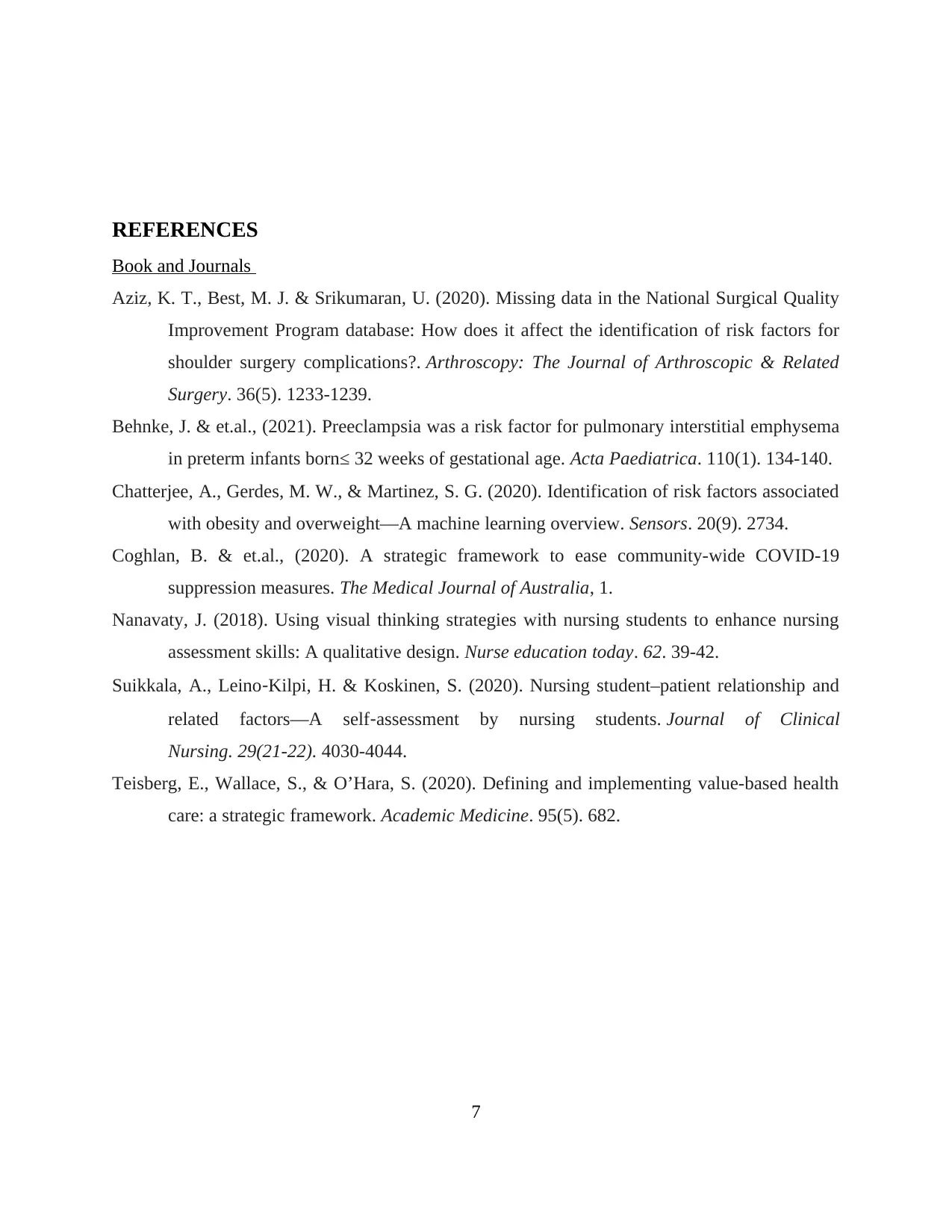
REFERENCES
Book and Journals
Aziz, K. T., Best, M. J. & Srikumaran, U. (2020). Missing data in the National Surgical Quality
Improvement Program database: How does it affect the identification of risk factors for
shoulder surgery complications?. Arthroscopy: The Journal of Arthroscopic & Related
Surgery. 36(5). 1233-1239.
Behnke, J. & et.al., (2021). Preeclampsia was a risk factor for pulmonary interstitial emphysema
in preterm infants born≤ 32 weeks of gestational age. Acta Paediatrica. 110(1). 134-140.
Chatterjee, A., Gerdes, M. W., & Martinez, S. G. (2020). Identification of risk factors associated
with obesity and overweight—A machine learning overview. Sensors. 20(9). 2734.
Coghlan, B. & et.al., (2020). A strategic framework to ease community-wide COVID-19
suppression measures. The Medical Journal of Australia, 1.
Nanavaty, J. (2018). Using visual thinking strategies with nursing students to enhance nursing
assessment skills: A qualitative design. Nurse education today. 62. 39-42.
Suikkala, A., Leino‐Kilpi, H. & Koskinen, S. (2020). Nursing student–patient relationship and
related factors—A self‐assessment by nursing students. Journal of Clinical
Nursing. 29(21-22). 4030-4044.
Teisberg, E., Wallace, S., & O’Hara, S. (2020). Defining and implementing value-based health
care: a strategic framework. Academic Medicine. 95(5). 682.
7
Book and Journals
Aziz, K. T., Best, M. J. & Srikumaran, U. (2020). Missing data in the National Surgical Quality
Improvement Program database: How does it affect the identification of risk factors for
shoulder surgery complications?. Arthroscopy: The Journal of Arthroscopic & Related
Surgery. 36(5). 1233-1239.
Behnke, J. & et.al., (2021). Preeclampsia was a risk factor for pulmonary interstitial emphysema
in preterm infants born≤ 32 weeks of gestational age. Acta Paediatrica. 110(1). 134-140.
Chatterjee, A., Gerdes, M. W., & Martinez, S. G. (2020). Identification of risk factors associated
with obesity and overweight—A machine learning overview. Sensors. 20(9). 2734.
Coghlan, B. & et.al., (2020). A strategic framework to ease community-wide COVID-19
suppression measures. The Medical Journal of Australia, 1.
Nanavaty, J. (2018). Using visual thinking strategies with nursing students to enhance nursing
assessment skills: A qualitative design. Nurse education today. 62. 39-42.
Suikkala, A., Leino‐Kilpi, H. & Koskinen, S. (2020). Nursing student–patient relationship and
related factors—A self‐assessment by nursing students. Journal of Clinical
Nursing. 29(21-22). 4030-4044.
Teisberg, E., Wallace, S., & O’Hara, S. (2020). Defining and implementing value-based health
care: a strategic framework. Academic Medicine. 95(5). 682.
7
Paraphrase This Document
Need a fresh take? Get an instant paraphrase of this document with our AI Paraphraser

8
1 out of 8
Related Documents
Your All-in-One AI-Powered Toolkit for Academic Success.
+13062052269
info@desklib.com
Available 24*7 on WhatsApp / Email
![[object Object]](/_next/static/media/star-bottom.7253800d.svg)
Unlock your academic potential
Copyright © 2020–2025 A2Z Services. All Rights Reserved. Developed and managed by ZUCOL.





